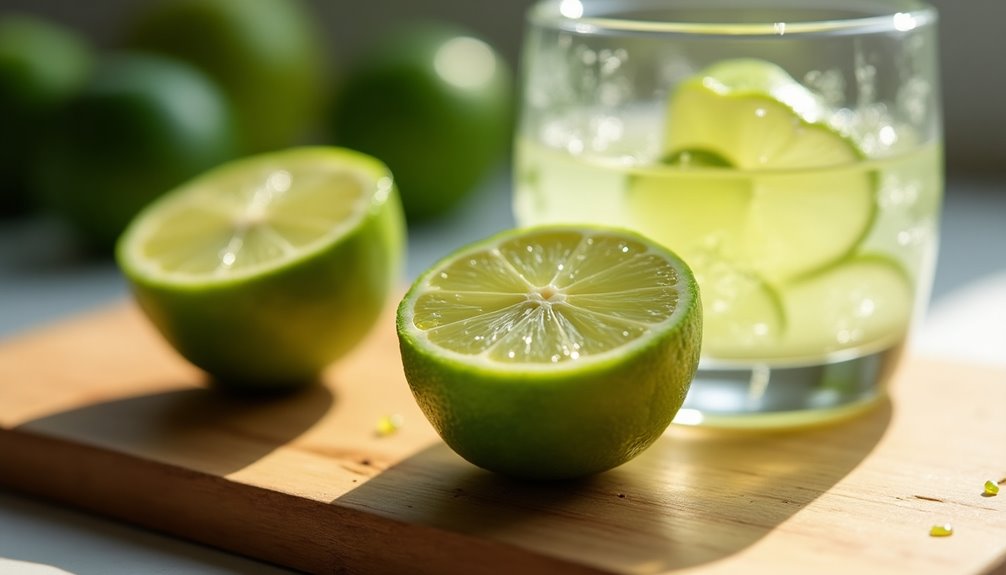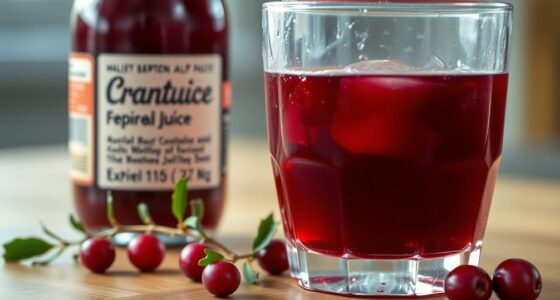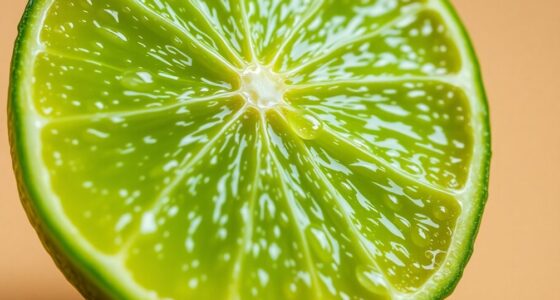One medium lime typically yields about 2 tablespoons, or 1 ounce, of juice. If you're looking to make 1/4 cup of lime juice, you'll need around 2 medium limes, while 1/2 cup requires about 4 limes. For best results, roll the limes under your palm to maximize juice extraction. This little trick can significantly increase your yield, making your cooking experience much more rewarding. Stick around to discover more tips on using limes in your kitchen!
Key Takeaways
- One medium lime typically yields about 2 tablespoons (1 ounce) of juice.
- For 1/4 cup of lime juice, approximately 2 medium limes are required.
- To extract more juice, roll the lime under your palm before squeezing.
- Size and ripeness of the lime can affect the total juice yield.
- It's advisable to have extra limes on hand for less juicy fruits.

Have you ever wondered how much juice you can squeeze out of a lime? You're not alone! Many home cooks and cocktail enthusiasts often find themselves in need of fresh lime juice but aren't quite sure how much they can expect from this zesty citrus fruit.
When it comes to limes, the average lime yields about 2 tablespoons, or 1 ounce, of juice. This means that if you're preparing a recipe that requires a specific amount of lime juice, you'll want to keep those yields in mind.
If a recipe calls for 1/4 cup of lime juice, you'll need approximately 2 medium limes. Likewise, if you've got a cocktail or dish that requires 1/2 cup, plan on using around 4 limes. It's always good to have a few extra limes on hand just in case the ones you pick out are smaller or not as juicy. The size and ripeness of the lime can slightly affect the amount of juice you extract, but on average, you can count on those standard yields to guide your cooking.
To maximize the juice you get from one lime, a little technique goes a long way. Before you slice it open on your cutting board, roll the lime under the palm of your hand. This simple step helps to break down the internal membranes, making it easier to squeeze out every last drop of that flavorful juice. You'll be surprised at how much more juice you can extract just by taking a moment to prep your limes this way.
Now, let's talk about the flavor. Fresh lime juice can elevate your dishes and drinks with its bright, tangy taste. Whether you're making a zesty marinade, a refreshing cocktail, or a sweet dessert, the juice from one lime can add that perfect citrus punch.
You'll find it complements a variety of ingredients, from seafood to desserts, making it a versatile staple in your kitchen. When you consider the amount of juice you can extract and the flavor it adds, the lime is truly a powerhouse among citrus fruits. Additionally, fresh lime juice is rich in antioxidants, which can contribute to overall health benefits.
It's compact but mighty, packing a punch in terms of taste and versatility. So next time you reach for a lime, remember the average lime yields about 2 tablespoons of juice, and plan accordingly.
Frequently Asked Questions
How Much Juice Is in 2 Limes?
When you’re juicing 2 limes, you can expect to get about 4 tablespoons of juice, or roughly 1/4 cup. This means that the average lime has a lime juice yield per fruit of about 2 tablespoons. Keep in mind that factors such as the size and ripeness of the limes can influence the amount of juice you extract. For the best results, roll the limes on a hard surface before juicing to help release more juice.
Each lime typically yields around 2 tablespoons, so you're looking at a total of about 2 ounces.
Keep in mind that the exact amount can vary a bit depending on the size and ripeness of the limes.
To maximize your yield, try rolling the limes on the countertop before cutting and juicing them.
Can I Substitute Bottled Lime Juice for Fresh Lime Juice?
Sure, you can swap bottled lime juice for fresh, but think of it like trading a vintage vinyl for a digital track—it just doesn't have the same vibe.
Bottled juice might seem convenient, but it often lacks the bright, fresh flavor you'd get from squeezing a real lime. For dishes where lime's the star, fresh juice truly shines.
If you're in a pinch, go for organic bottled options for a better taste.
How Much Juice Is in One Key Lime?
When you're working with a key lime, expect to get about 1 tablespoon of juice from each one.
Since these limes are smaller and rounder than their Persian counterparts, you'll need around 20 key limes to make 1/2 cup of juice.
Their higher acidity and unique floral flavor can enhance your recipes, but remember to adjust your quantities since they yield less juice than standard limes.
How Many Tsp Is 2 Limes?
When you juice 2 limes, you'll typically get about 12 teaspoons of juice.
Since each medium lime usually yields around 6 teaspoons, it's easy to measure the amount you need for your recipe.
Whether you're making a zesty dish or mixing up a refreshing cocktail, knowing that 2 limes provide a total of 4 tablespoons ensures you can achieve the perfect flavor balance.
Conclusion
In the end, when you squeeze that one lime, you're not just extracting juice; you're unlocking a little burst of sunshine. While it may seem modest, each drop carries the essence of fresh flavor, ready to elevate your dishes or drinks. So, the next time you reach for a lime, remember: it's not just about the juice—it's about the joy and zest it brings to your culinary adventures. Let those vibrant droplets inspire your creativity!
Cindy thoroughly researches juicing trends, techniques, and recipes to provide readers with practical advice and inspiration. Her writing style is accessible, engaging, and designed to make complex concepts easy to understand. Cindy’s dedication to promoting the advantages of juicing shines through her work, empowering readers to make positive changes in their lives through the simple act of juicing.











